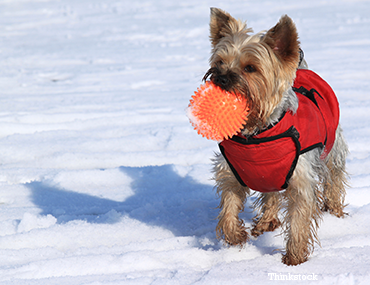For more from Dr. Justine Lee, find her at www.drjustinelee.com or on Facebook!
As winter approaches, we want to make sure our four-legged friends are safe from the elements. After all, people can bundle up, but our pets can’t add extra layers on a whim. During the winter a change of sun exposure and sunlight will affect your pet’s hair growth, and stimulate a thicker coat. This adds some protection during the cold seasons, but for dog breeds with thin or short hair, cold weather poses a threat (e.g., greyhounds, Italian greyhounds, whippets and boxers). Keep in mind that underlying medical problems (like an underactive thyroid or “hypothyroidism,” skin disease, cancer, immune-related diseases) or certain medications (e.g., heart medication, diuretics, and steroids) prevent your pet from having a normal metabolism and being able to thermoregulate appropriately.
An important consideration as temperatures drop is wind chill. Wind chill, which is always lower than air temperature, is the perceived decrease in temperature felt due to the effects of wind and airflow. Keep in mind that the temperature alone shouldn’t guide you on cold weather threats, but rather, the overall temperature after accounting for wind chill should be what guides you. So if it’s 30°F out and you want to go walk your dog, go for it. Just keep in mind that it may feel colder than that and your pet may need some extra protection (e.g., booties or dog sweater/jacket).
As I’m based out of Minnesota (where it’s winter 6 months out of the year), I know how severe cold injuries can be to pets. Here are some cold weather tips to keep your pet safe:
Bundle up
If your dog doesn’t have a thick, plush, hair coat consider a winter jacket when temperatures drop below 20°F. Make sure the jacket is snug and that your male dog doesn’t urinate on the bottom belly strap (which can then worsen frostbite or cold injury).

Watch where you salt
While ice salt is only mildly poisonous to dogs, it can cause irritation to the skin, paws, and gastrointestinal tract when directly ingested. Make sure to use pet-friendly ice melters (which don’t contain salt). More importantly, since you don’t know what your neighbors have put down, make sure to use a damp cloth to wipe off your pet’s paws after coming into the house.
Shelter
If your dog lives outside, make sure he has appropriate shelter, which should be out of the wind and off the ground. Direct contact with the ground, snow or ice results in conductive cooling, and isn’t appropriate in cold weather. Dry bedding, such as a thick bed of straw or other insulating protection should be used within the shelter. Make sure to provide a heated water source, as these can easily freeze. You can use thermal heaters specifically designed to keep water bowls from freezing.
Have an indoor/outdoor cat? Make sure to provide a safe, warm shelter. More importantly, make sure to “bang” on your car hood before starting the car (this is particularly important if you see paw prints on your hood). Cats often hide under a vehicle’s hood when it’s warm and can develop severe fan belt injuries (including broken jaw bones, severe lacerations, etc.) when the car is started.
Avoid space heaters
Avoid the use of space heaters, and other sources of external heat, due to the potential for carbon monoxide poisoning, accidental fire, or thermal injury to your pet.
Keep an eye out for frostbite
20 minute walks outside are unlikely to result in a problem, but if you take your dog skijoring (skiing behind your dog) or running for prolonged hours at a time, ice crystals can develop in peripheral tissues (like the ears, prepuce, vulva, tail tip, and toes). Keep a careful eye out for the following signs:
- redness
- coolness to touch
- swelling
- eventual sloughing of the tissue
What to do if you notice signs of frost-nip
If you do notice any signs of frost-nip (the stage immediately before frostbite) or frostbite, make sure to bring your pet into a sheltered, warm area immediately. Most importantly, avoid touching or actively heating the area aggressively; rather, slow re-warming of the tissue with lukewarm water is best. This will prevent further injury with rapid thawing of the ice crystals in the tissue. Seek immediate attention from your veterinarian to make sure pain medication, salves, or antibiotics aren’t necessary. Keep in mind that once tissue has undergone frostbite, that tissue is more susceptible in the future.
Winter doesn’t mean that you have to hide with your pet indoors – you should still enjoy the beautiful, cold outdoors. It provides stimulation, exercise, and fresh air. Just make sure you’re keeping your pet safe from these cold weather dangers.
If you have any questions or concerns, you should always visit or call your veterinarian – they are your best resource to ensure the health and well-being of your pets.
